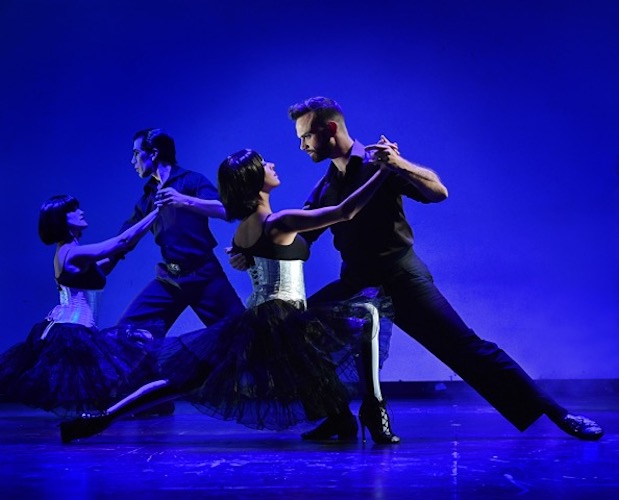Dance Review: Fernanda Ghi Dance Company — Passion, Fury, and Enigma
By Jessica Lockhart
Black + White from the Fernanda Ghi Dance Company was provocative, dramatic, and oh-so-mysterious.
Fernanda Ghi Dance Company, presented by Global Arts Live at the Calderwood Pavilion at the Boston Center for the Arts, Boston, MA on October 13.

The Fernanda Ghi Dance Company in action during “Black + White.” Photo: courtesy of the artist.
Tango dancers are inevitably passionate. It comes with the territory in a dance form that demands partnering which is as sensual as it is theatrical. And there was plenty of sexual heat in Fernanda Ghi Dance Company’s Black + White. But the presentation was more than that — unexpectedly, serious subjects were explored — grief, memory, love, and death among them — in a performance that fused traditional Argentine tango with the psychological/political concerns of contemporary dance.
Black + White was a piece that offered more than just intimations of mortality. The company’s founder and artistic director Fernanda Ghi collaborated with photographer Andres Mario de Varona, drawing on photographs from his series Contact, which concentrates on his late mother, her rituals as well as some of the objects she owned. Selected photos were projected on stage as a backdrop for the movements of the dancers. de Varona’s collection was inspired by his mother’s death, while Ghi’s choreography was designed shortly after her father’s passing.
The female dancers entered the stage costumed in black-and-white stripped leggings and white corsets. They all wore black wigs of an identical style. It was hard to tell the performers apart because they all looked similar in size and height. There was a point to this sameness (perhaps): it was an attempt to show how all the female performers represented one woman as she went through various parts of her life.
The program was divided into four acts. But before the acts began all eight dancers rushed to the front of the stage and stared out at the audience members. A voice intoned: “Art creates it’s own reality. You don’t need to be an expert to watch dance. We are here because you are here.”
In Act One, “Loco Amor Loco” (Crazy, Crazy Love), a distraught woman entered carrying a ragged scarf. A bride and groom appeared. The bride began to turn in a circle, over and over, after the groom leaves her to dance with the ‘crazy’ woman. The first photograph is unveiled: it shows a newly married couple, smiling. But we see this image through a gauzy piece of fabric that is ripped and torn, held together by some string. Is the distraught woman an older version of the bride? The groom goes back to the bride; the ‘crazy’ woman tries to untangle him from her. They perform a tension-filled trio dance: he moves with one woman and, as he turns, he slides into the arms of the other. Finally, groom shoos away the ‘crazy’ woman. She runs in circles around the pair, becoming increasingly upset.

Fernanda Ghi Dance Company in a scene from “Black + White.” Photo: courtesy of the artist.
In Act Two, “La Luna Y Vos” (You and the Moon) a stark and forlorn photo focuses on the backside of naked man who is sitting on the floor, slumped forward. A giant white orb surrounds the body. In her program notes, choreographer Ghi explains that “… the moon is a womb that gives birth to the day and light.“ Two dancers performed traditional tango partnering, displaying an exceptional range of quick feet movements and intricate leg gestures. Eventually, they took up a slow, intricately expressive movement that oozed across the stage space. It was a lament, possibly for lost love, perhaps an attempt to remember why they had to forsake each another. The act ended as they rushed into an embrace.
For Act Three, “Sonando “(Dreaming), the music abruptly shifted from the classic rhythms of Argentinian composer Astor Piazzolla and his Nuevo Tango to a darker, eerier sound created by Richard Scofano. The sonic atmosphere was piercing The dancers moved around the stage in semi-darkness. We saw a couple lying on the floor together underneath a shroud. As the cloth was lifted, we saw that the woman wasn’t wearing the black and white leggings and white corset familiar from the other two acts. She is wrapped again in the shroud, and the couple dance together. But, when they stop, the shroud is removed and she slumps forward. A photograph appears: it also shows a couple under a shroud. But now they are lying on a couch. Was the woman a ghost? Are we watching memories of the dead?
Finally, in Act Four, “Invocacion” (A Call To Action), the photo gives us a pair of high heel shoes placed on a dining room table. The women brought a giant piece of fabric on stage and used it to create a kind of boxing ring that enveloped the men. They were trapped. They danced in short spurs, as if on display, for some reason needing to prove their skill. This struggle evolved into some gorgeous partnering duos with the women. All eight dancers shined as they delivered fiercer and fiercer movements that surged and grew stronger. The passion escalated with each duet and culminated with a superbly grand finale. After the curtain call, just when the show was apparently over, the performers once again came to the front of the stage. They stared out at the audience, as the voice asked “What was your interpretation? What was the meaning for you?”
Jessica Lockhart is a National Endowment for the Arts Fellow in Dance Criticism and has a BA in Communication from the University of Southern Maine. Lockhart is a Maine Association of Broadcasters award winning independent journalist. Currently, she also works as program director at WMPG Community radio.
Tagged: Andres Mario de Varona, Fernanda Ghi, Fernanda Ghi Dance Company, Global Arts Live
